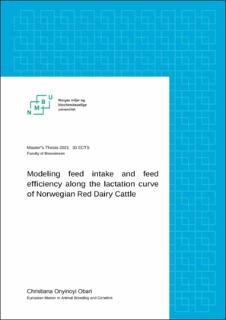| dc.contributor.advisor | Meuwissen, Theodorus | |
| dc.contributor.advisor | Schmitt, Armin | |
| dc.contributor.author | Obari, Christiana Onyinoyi | |
| dc.date.accessioned | 2021-11-05T13:52:51Z | |
| dc.date.available | 2021-11-05T13:52:51Z | |
| dc.date.issued | 2021 | |
| dc.identifier.uri | https://hdl.handle.net/11250/2828199 | |
| dc.description.abstract | Including feed efficiency into breeding goals could be a key in ensuring sustainable dairy cattle production as selection could be based on how efficient a cow is in terms of what it consumes and produces all through the lactation period. Hence, prioritizing feed efficiency could aid profitability and reduced methane emission in dairy cow sector.
The objective of this study was to explore random regression models of varying order of Legendre polynomials to fit feed intake and feed efficiency records in Norwegian Red dairy cows. Data included 2632 daily dry matter intake and average daily milk yield records from 45 cows in 1 to 5 parities for 56 days of lactation. A random regression model with both random and fixed regressions fitted by Legendre polynomials of order 1 to 5 for fixed effects curve and 1 to 2 for random animal effect curve were compared while accounting for homogeneous and four heterogeneous classes of residual variance across the lactation. Models were evaluated by goodness of fit (LogL and -½ AIC values), graphical inspection of variance functions for the random animal effect, while difference between the standard error and regression solution for the fixed effect curves.
The results showed improvement in goodness of fit moving from order 1 to order 2 but order 3 showed no convergence for the animal random effect in both feed intake and feed efficiency models. For feed intake analyses, order 1,2,4 and 5 was significant while for feed efficiency analysis only order 3 was significant for fixed effect curves. In general, the result showed that random regression models using fifth order Legendre polynomials (Mleg5) for fixed effect curve and first order Legendre polynomials (Aleg1) with heterogeneous residual variance was sufficient to fit feed intake records. While random regression models using third order Legendre polynomials (Mleg3) for fixed effect curve and second order Legendre polynomials (Aleg2) with homogeneous residual variance was sufficient to fit feed efficiency data.
In conclusion, random regression model with Legendre polynomial of order 3 for fixed effect curve and order 2 with homogeneous classes of residual variances is a good model for fitting feed efficiency records, Legendre polynomial of order 5 for fixed effect curve and order 1 with heterogeneous residual variances could be an appropriate model to consider while fitting feed intake records to avoid complexity of the models. | en_US |
| dc.language.iso | eng | en_US |
| dc.publisher | Norwegian University of Life Sciences, Ås | en_US |
| dc.rights | Attribution-NonCommercial-NoDerivatives 4.0 Internasjonal | * |
| dc.rights.uri | http://creativecommons.org/licenses/by-nc-nd/4.0/deed.no | * |
| dc.subject | Dairy cattle | en_US |
| dc.subject | Feed intake | en_US |
| dc.subject | Feed efficiency | en_US |
| dc.subject | Lactation stage | en_US |
| dc.subject | Random animal effect | en_US |
| dc.subject | Residual variance(s) | en_US |
| dc.subject | Norwegian Red | en_US |
| dc.subject | Milk yield | en_US |
| dc.title | Modeling feed intake and feed efficiency along the lactation curve of Norwegian Red Dairy Cattle | en_US |
| dc.type | Master thesis | en_US |
| dc.subject.nsi | Animal breeding | en_US |
| dc.description.localcode | EM-ABG | en_US |

